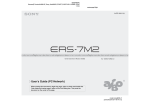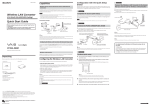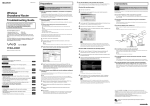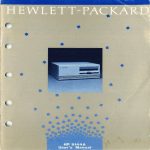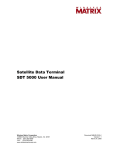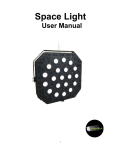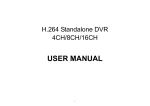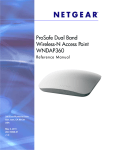Download User Guide
Transcript
A-CC1-100-11 (1) When printing this document to legal size paper, place a check mark beside the “Auto-rotate and center pages” option of the Print dialog box. This prints the document on the center of the page. Table of contents Welcome to the AIBO® Entertainment Robot ERS-7M3 PC network . . . . . . . . . . . . . . . . . . . . . . . . . . . . . . . . . . . 4 Network Configuration Confirming system requirements . . . . . . . . . . . . . . . . . . 6 Enabling the Wireless LAN function . . . . . . . . . . . . . . . 7 AIBO® Entertainment Robot’s network setup . . . . . . . . 8 Network setup procedure . . . . . . . . . . . . . . . . . . 8 Installing “AIBO WLAN Manager 3” . . . . . . . . 9 Configuring network settings with “AIBO WLAN Manager 3” . . . . . . . . . . . . . . . . . . . . . . . . . . . . . 10 AIBO Photo Album Viewing pictures with the AIBO Photo Album . . . . . . . 18 The AIBO EYES Feature Various AIBO EYES functions . . . . . . . . . . . . . . . . . . . 22 Viewing pictures taken by the AIBO® Entertainment Robot on your PC or mobile communication device* . . . . . . . 31 The AIBO robot’s posture when taking pictures . 31 Taking pictures on command . . . . . . . . . . . . . . . 32 Taking periodic pictures at a set interval with the [WATCH command] . . . . . . . . . . . . . . . . . . . . . . 34 Viewing pictures stored on the AIBO MIND 3 software “Memory Stick™” media . . . . . . . . . . . 36 Turning House Sitting Mode ON and OFF with the [HSMODE command] . . . . . . . . . . . . . . . . . . . . . 36 Sending the AIBO® Entertainment Robot a message or song . . . . . . . . . . . . . . . . . . . . . . . . . . . . . . . . . . . . . . 37 Having the recipient play back the AIBO robot’s message and/or song [MSG command]. . . . . . . . 37 Having the AIBO® Entertainment Robot play back the message or song immediately [PLAY command] . . . . . . . . . . . . . . . . . . . . . . . . . . . . . . . . . . . . . . . 39 Recording unique messages/recording Voice Signatures . . . . . . . . . . . . . . . . . . . . . . . . . . . . . . 39 The AIBO® Entertainment Robot will notify you of new e-mail . . . . . . . . . . . . . . . . . . . . . . . . . . . . . . . . . . . 40 Configuring e-mail . . . . . . . . . . . . . . . . . . . . . . . . . . . . . 24 AIBO MAIL . . . . . . . . . . . . . . . . . . . . . . . . . . . . . . . . . . 30 Writing AIBO MAIL . . . . . . . . . . . . . . . . . . . . . 30 Checking for e-mail . . . . . . . . . . . . . . . . . . . . . . 30 Additional Information Notes on use . . . . . . . . . . . . . . . . . . . . . . . . . . . . . . . . . . 42 Troubleshooting . . . . . . . . . . . . . . . . . . . . . . . . . . . . . . . 43 2 Appendix Words that the AIBO® Entertainment Robot can understand (AIBO EYES feature) . . . . . . . . . . . . . . . . . . . . . . . . . . 46 Command parameter list (for AIBO MAIL commands) 47 PHOTO, PHOTOL, WATCH command parameters . . . . . . . . . . . . . . . . . . . . . . . . . . . . . . 47 MSG, PLAY command parameters . . . . . . . . . . 48 AIBO® Entertainment Robot ERS-7M3 light . . . . . . . . 49 Viewing pictures taken by the AIBO® Entertainment Robot with a “Memory Stick™” media reader/writer . . . . . . . 50 Error e-mail examples . . . . . . . . . . . . . . . . . . . . . . . . . . 51 Editing “WLANCONF.TXT” manually . . . . . . . . . . . . 53 WLANCONF.TXT parameter list . . . . . . . . . . . 57 ® AIBO Entertainment Robot network settings . . . . . . . 59 Glossary . . . . . . . . . . . . . . . . . . . . . . . . . . . . . . . . . . . . . 60 Before using this software, please read the accompanying End-User License Agreement which governs use of this software. • This software or document is protected by copyright, and distributed under licenses restricting its use, copying, and distribution. No part of this software or document may be reproduced in any form by any means and rental of this software may not be allowed without prior authorization of Sony® Corporation. • Sony Corporation assumes no responsibility for any inconvenience caused by misuse or any use not stated in this document. • The supplied software cannot be used with any device other than those devices specified herein. • Some mobile communication devices may not work with the AIBO EYES feature due to unique configurations. Sony Corporation assumes no responsibility, in the case that the AIBO EYES feature does not work with such mobile communication devices. • The specifications of the supplied software are subject to change without notice. “OPEN-R” is the standard interface for the AIBO Entertainment Robot system that Sony is actively promoting. This interface expands the capability of the entertainment robot through a flexible combination of hardware and interchangeable software to suit various applications. The AIBO robot ERS-7M3 conforms to OPEN-R version 1.1.5. “AIBO”, the AIBO logo , “OPEN-R” and the OPEN-R logo , “Memory Stick”, and are trademarks or registered trademarks of Sony Corporation. Microsoft and Windows are registered trademarks of Microsoft Corporation in the United States and/or other countries. All other names of systems, products and services are trademarks of their respective owners. Other information about the AIBO robot is available on the Internet at the following site: http://www.aibo.com Reproduction in whole or in part without written permission is prohibited. All rights reserved. 3 Welcome to the AIBO® Entertainment Robot ERS-7M3 PC network Using the wireless LAN functionality of the AIBO Entertainment Robot ERS-7M3, you can view pictures taken by your AIBO robot in the AIBO Photo Album, in real-time. You can also use your mobile communication device* (with Internet connectivity) or a standard connection to the Internet to play with the AIBO EYES feature. With AIBO Entertainment Player Version 2.0, you can control your AIBO robot remotely, use it to enjoy music, read its diary, and more. E-mail server Network settings (page 8) AIBO Entertainment Player First, set up the network. See the “User’s Guide (AIBO Entertainment Player Ver. 2.0)”. AIBO EYES feature (page 21) By sending the AIBO robot an e-mail while you are away from home, you can have it take pictures, forward pictures taken in House Sitting mode as an attachment, and convey messages to family and friends who are in the vicinity of the AIBO robot. AIBO Photo Album (page 17) You can use a Web browser to access your AIBO robot and browse the pictures it has taken. Wireless LAN access point Click The AIBO MIND 3 software “Memory Stick™” media * Your mobile communication device must have a JPEG e-mail viewing capability. 4 Network Configuration In this section, we will confirm the system environment and set it up to use the AIBO® Entertainment Robot’s wireless LAN connection. Network Configuration Confirming system requirements To use the AIBO EYES feature, your system must meet the following requirements. Caution The AIBO EYES feature cannot be used with USBtype cable and DSL modems. E-mail server A PC is required to configure the AIBO® Entertainment Robot’s network and mail settings, as well as to view pictures taken by the AIBO robot via a Web browser. A “Memory Stick™” media reader/writer*1 is required. • In order to connect your PC to an access point via a wireless LAN, your PC must have an IEEE 802.11b compatible wireless LAN adaptor. • A Web browser must be installed. • An e-mail account that supports POP*2 receiving and SMTP sending is required. PC (connected to a wired LAN) Broadband (e.g. Cable modem, DSL, etc.) To the Internet Modem Access point for Wireless LAN The system must always be connected to the Internet. PC (connected to a wireless LAN) Either the modem or the access point must have a router function. Please set the authorization mode to “Open System Authorization”. You can specify either WEP-encrypted or unencrypted network communication. *1 Only Sony products are guaranteed to operate correctly. *2 The POP server must support the UIDL command (the command that displays a listing of IDs attached to individual e-mail messages). Check with your Internet service provider to determine whether support is available for your e-mail account. The AIBO MIND 3 software “Memory Stick” media The AIBO robot Energy Station ERA-7P1 When taking pictures of a certain scene at set intervals, place the AIBO robot on its Energy Station. The AIBO robot’s clock features, as well as userdefined sleep/wake-up features are only available while the AIBO robot is in Station mode. Using only the AIBO Photo Album • An e-mail account and continuous Internet connection are not needed. • A PC that supports a wireless LAN can be used in place of a wireless LAN access point. 6 In order to enable the AIBO® Entertainment Robot’s wireless LAN function, turn the wireless switch on its body to ON. If the AIBO robot is still operating, first press the pause button to put the AIBO robot in Pause mode. 1 Hold the AIBO robot firmly, turn it upside down, and open the cover. 2 Network Configuration Enabling the Wireless LAN function Slide the wireless switch to ON, and close the cover. Caution Simply turning ON the switch will not make the wireless LAN function usable. Refer to the next page for instructions on how to set up the network. Notes Caution • When lifting the AIBO robot, always hold it by its body, and not its extremities. (Those with small hands may have difficulty handling the AIBO robot.) • Do not touch the charging terminal on the AIBO robot’s stomach with your bare hands. Touching the contacts will reduce contact quality. 7 Network Configuration AIBO® Entertainment Robot’s network setup This section will guide you through the setup needed to enable your AIBO robot’s wireless LAN function. A “Memory Stick™” media reader/writer* is required to set up the network. * Only Sony products are guaranteed to operate correctly. Network setup procedure Which OS are you running? If you are using the Microsoft® Windows®*1 98 SE, Windows Me, Windows 2000, or Windows XP (Home Edition or Professional) operating system. Use “AIBO WLAN Manager 3”*2 from the CD-ROM included with the AIBO Entertainment Robot ERS-7M3, to configure the AIBO MIND 3 software “Memory Stick” media to match your network settings. For other operating systems (Windows 98, Mac OS®, etc.), you can change the AIBO MIND 3 software “Memory Stick” media settings directly to match your network configuration. For details, refer to “Editing “WLANCONF.TXT” manually” on page 53. Refer to the next page for setup instructions. *1Hereafter shortened to “Windows”. *2“AIBO WLAN Manager 3” is a utility program used to configure the wireless LAN connection settings on the AIBO robot. “AIBO WLAN Manager 3” runs under the Windows 98 SE, Windows 2000, Windows Me, and Windows XP (Home Edition/Professional) operating systems. 8 Installing “AIBO WLAN Manager 3” Network Configuration Install “AIBO WLAN Manager 3” on your PC. Insert the CD-ROM included with the AIBO® Entertainment Robot ERS-7M3 into your CD-ROM drive. The installer will automatically start. If the installer does not start, double-click the “Setup.exe” file in the CD. Follow the on-screen instructions to install the software. Windows® XP users must install Universal Plug and Play (UPnP) (If you are not using Windows XP, the following procedure is unnecessary.) Windows XP operating system users must install Universal Plug and Play (UPnP) in order to use the AIBO robot’s search function. Use the following procedure to install Universal Plug and Play (UPnP). 1 Click “Start”t “Control Panel”. 2 Select “Add/Remove Programs” t “Add/Remove Windows Components”. 3 In the “Components” list, select the “Network Services” check box, and then click “Details”. 4 Select the “Universal Plug and Play” check box, and then click “OK”. If you used a CD to install the Windows operating system, you will be prompted to insert it into your computer. 5 Click “Next” to start installation. 6 When the “Completed the Windows Components Wizard” screen appears, click “Finish”. Installation of Universal Plug and Play (UPnP) is now complete. 7 Close the “Add/Remove Programs” window. 8 Close the “Control Panel” window. 9 If you are using Windows® XP SP2 (Service Pack2) and Windows Firewall is set to block the UPnP Framework service, the AIBO search function will not be able to detect the AIBO robot. Follow the steps below to add the UPnP Framework to the list of unblocked services. 1Click “Start” t “Control Panel”. 2Double-click “Windows Firewall”. 3Click the “Exceptions” tab on the “Windows Firewall” window. 4Place a check mark by “UPnP Framework” in the “Programs and Services” list, and click “OK”. 5Close the “Control Panel” window. Configuring network settings with “AIBO WLAN Manager 3” Use “AIBO WLAN Manager 3” to configure the AIBO MIND 3 software “Memory Stick™” media to match your network settings. 1 2 Insert the AIBO MIND 3 software “Memory Stick” media into the “Memory Stick” media reader/writer. Network Configuration Caution Caution Make sure the AIBO MIND 3 software “Memory Stick” media safety switch is not in the “LOCK” position. If the switch is set to “LOCK”, then the AIBO® Entertainment Robot’s network settings and pictures will not be stored. 3 Configure each setting to match your network environment, and click Write. Configuration options will differ depending on whether your network is using a DHCP Server*. The DHCP server allows an IP address to be automatically allocated to a device on the network. * For details on DHCP server functionality, refer to the instruction manuals included with your modem or access point. If using the Windows XP operating system, click “Start” t “All Programs” t “AIBO WLAN Manager” t “AIBO WLAN Manager 3”. If using an operating system other than Windows XP, click “Start” t “Programs” t “AIBO WLAN Manager” t “AIBO WLAN Manager 3”. “AIBO WLAN Manager 3” starts, and the “AIBO WLAN Manager 3” dialog box appears. 10 Network Configuration Use the following procedure to confirm whether or not you are using a DHCP server in your network environment (This procedure is for the Windows® XP operating system only. If using another operating system, consult its Help.) 1 Click “Start” t “Control Panel”. 2 Click “Network and Internet Connections” t “Network Connections”. 3 Right-click either “Wireless Network Connection” or “Local Area Connection”, and select “Properties”. 4 On the “General” tab, select “Internet Protocol (TCP/IP)” under “This connection uses the following items”. Click “Properties”. 5 Confirm your settings. If “Obtain an IP address automatically” is selected The DHCP server function is in use. Proceed to page 12. If “Use the following IP address” is selected You are not using a DHCP server. Proceed to page 13. c In this case, use the following steps to manually assign your AIBO® Entertainment Robot an IP address. Make a note of your PC’s IP address displayed under “Use the following IP address”. Choose an IP address for your AIBO robot that does not conflict with this. E.g. Your PC’s IP address: 192.168.0.10 t Your AIBO robot’s IP address: 192.168.0.11, etc. (anything other than 192.168.0.10) 11 When using a DHCP server in your network environment Network Configuration Configure settings on the “Easy” tab. When using a DHCP server, changes to the “Advanced” tab (page 13) are unnecessary. 1 Click the “Browse” button, and specify the drive where the AIBO MIND 3 software “Memory Stick™” media is set (e.g. “E:” drive). 2 The name that you enter here will appear as the “AIBO Name” on the “AIBO Search” tab (page 14). This name can be up to 8 alphanumeric characters and must contain at least one letter. 3 Enter the network name (SSID) used by the wireless LAN access point. (Maximum of 32 characters. Only alphanumeric characters and symbols are allowed.) 4 Configure if using WEP (page 62). (If not using WEP, no settings are necessary.) If using WEP, select the “Enable WEP Encryption” check box, and enter the passkey (WEP)* for the wireless LAN access point. (Passkeys must consist of alphanumeric characters or symbols. For [ASCII], the passkey must be 5 or 13 characters. For [HEX], it must be 10 or 26 characters.) Set the network authorization to “Open System”. Example Configuration Alphanumeric Hexadecimal WEP64 (40 bit) AIBO2 4149424f32 WEP128 (104 bit) ENTERTAINMENT 454e5445525441494e74d454e54 5 Confirm your settings, and click this button. * To insure security, the encrypted passkey (WEP) is displayed with 13 asterisks (*) for ASCII and 26 for HEX, regardless of the number of characters entered. 12 When not using a DHCP server in your network environment Network Configuration Configure settings in the “Advanced” tab. When not using a DHCP server, changes to the “Easy” tab (page 12) are unnecessary. 1 Click the “Browse” button, and specify the drive where the AIBO MIND 3 software “Memory Stick™” media is set (e.g. “E:” drive). 2 Enter the network name (SSID) used by the wireless LAN access point. (Maximum of 32 characters. Only alphanumeric characters and symbols are allowed.) 3 Configure if using WEP (page 62). (If not using WEP, no settings are necessary.) If using WEP, select the “Enable WEP Encryption” check box, and enter the passkey (WEP) used by the wireless LAN access point. Alphanumeric passkeys must be 5 or 13 characters. Hexadecimal passkeys must be 10 or 26 characters. 4 Select “Use the following IP address”, and fill in the following fields: •Enter the IP address* that the AIBO® Entertainment Robot is using. •Enter the subnet mask that the AIBO robot is using. •Enter the IP address of the device that is acting as a router. 5 Select the “Enable SSDP” check box. 6 Select this option and enter the IP address of the device that is acting as a router. The name that you enter here will appear as the “AIBO Name” on the “AIBO Search” tab (page 14). This name can be up to 8 alphanumeric characters and must contain at least one letter. 7 Confirm your settings, and click this button. * For information on your AIBO robot’s IP address, refer to page 11. zHint For additional settings, refer to “AIBO Entertainment Robot network settings” on page 59. 13 Remove the AIBO MIND 3 software “Memory Stick™” media from the reader/writer. Insert it into the AIBO® Entertainment Robot, and press the pause button on the AIBO robot’s back to activate the AIBO robot. Pause button AIBO MIND 3 software “Memory Stick” media Network Configuration 4 For instructions on inserting the “Memory Stick” media, refer to the “User’s Guide (Basic)”. 5 Once your AIBO robot is activated, go to the “AIBO Search” tab in the “AIBO WLAN Manager 3” dialog box, and click Search. An icon appears if the AIBO robot is on the same network as your PC. An icon will appear only if the “Enable SSDP” check box was selected. After clicking “Search”, the AIBO robots using the same network as the PC are shown. When you click an AIBO icon in the list above, information for that AIBO robot is displayed. When you click the URL shown, the top page of the “AIBO MIND 3” Web site is opened. Click this button. zHints • If the AIBO icon does not appear even after clicking the “Search” button, then the PC cannot communicate with the AIBO robot wirelessly. Confirm the settings on the “Easy” and “Advanced” tabs. Also, check that the wireless switch (page 7) on the AIBO robot’s body is set to ON. • Windows® XP operating system users must install Universal Plug and Play (UPnP) in order to use the AIBO search function. For the installation procedure, refer to page 9. • You can confirm the IP address in Clinic Mode. See “Confirming the AIBO® Entertainment Robot’s IP address” (page 16). 14 Click Finish to close the “AIBO WLAN Manager 3” dialog box. Network Configuration 6 You’ve completed this process! You can now communicate with your AIBO® Entertainment Robot wirelessly! Making the AIBO robot inaccessible from other users To prevent other people from accessing your AIBO robot, you can apply security measures with AIBO WLAN Manager 3. By setting a user ID and password here, every time your AIBO Photo Album and AIBO EYES feature pages are accessed from a Web browser, a screen will appear to request your user ID and password. 1 Enter a user ID and password of 8 alphanumeric characters or less here. If you are not going to apply security measures, leave these fields blank. 2 Confirm your settings, and click this button. 3 Click this button, and close the AIBO WLAN Manager 3 dialog box. The user ID and password set here will also be needed to configure the settings for AIBO Entertainment Player. For details, see the “User’s Guide (AIBO Entertainment Player Ver. 2.0)”. 15 Network Configuration Confirming the AIBO® Entertainment Robot’s IP address You can confirm your AIBO robot’s IP address in Clinic Mode of the voice guide menu. For details on how to use Clinic Mode, refer to the “User’s Guide (Basics)”. 1 Simultaneously touch the front and rear back sensors for 3 seconds, or show the AIBO robot the “Clinic Mode (O)” card. (Next, follow the voice guide.) If you have used the “Clinic Mode (O)” card, the voice guide is heard immediately. 2 Execute the “Modes/actions check” in Clinic Mode. If wireless communication is activated, the AIBO robot reports its IP address. 16 AIBO Photo Album You can use your Web browser to view pictures taken by the AIBO® Entertainment Robot. Viewing pictures with the AIBO Photo Album Here you will learn how to view pictures over a wireless LAN. For instructions on using a “Memory Stick” media reader/writer to view pictures stored on the AIBO MIND 3 software “Memory Stick” media, refer to page 50. 1 Start your PC’s Web browser, and access the following address: http://XXX.XXX.XXX.XXX 2 AIBO Photo Album Pictures taken by the AIBO® Entertainment Robot are stored on its “Memory Stick™” media. Pictures taken by the AIBO robot are classified in the AIBO Photo Album as: • Pictures taken by voice commands, AIBO card and AIBO MAIL • Pictures and Sounds recorded during House Sitting mode • Friendly faces • Favorite things • Favorite place • Today’s souvenir picture Click [Pictures taken by AIBO] under [AIBO PHOTO ALBUM]. A list of pictures stored on the “Memory Stick” media is displayed. Note If you have set a user ID and password with AIBO WLAN Manager 3, an input screen appears for your user ID and password. AIBO robot IP address Alternatively, you can double-click the AIBO robot icon on the “AIBO Search” tab (page 14) of “AIBO WLAN Manager 3”. zHint For information on your AIBO robot’s IP address, refer to page 11. The AIBO MIND 3 software top page is displayed. 18 AIBO Photo Album • Pictures taken by voice commands, AIBO card, and AIBO MAIL (Max. 10) This displays the photos taken by the AIBO robot when told to “Take a picture”, shown the “Photo (B)” card, or sent an AIBO MAIL from a PC or mobile communication device. • Pictures and sounds recorded during House Sitting mode (Max. 15) This displays the photos taken by the AIBO robot while in House Sitting mode. You can also listen to sounds the AIBO robot has recorded (page 20). • Friendly faces (Max. 3) This displays the photos of the registered owners of the AIBO robot. • Favorite things (Max. 3) This displays the photos of the registered favorite things of the AIBO robot. • Favorite place (Max. 1) This displays the photo taken by the AIBO robot of its favorite place. • Today’s souvenir picture (Max. 1) This displays the photo taken by the AIBO robot for its diary. Click on an image to display an enlarged version in a separate window. Picture resolution is 416 × 320 pixels. * Please ensure that you are using Microsoft® Internet Explorer 6. * The images shown above are displayed in Web pages, so their resolutions differ from that of the actual pictures taken by the AIBO® Entertainment Robot. 19 zHints AIBO Photo Album • To view the most recent picture, reload the web page. • Set the Web browser cache appropriately. − With Microsoft Internet Explorer 6: Click “Internet Options” in the “Tools” menu, open the “General” tab in the window that appears, and click “Settings” under “Temporary Internet files”. Next, change the “Check for newer versions of the stored pages” setting to “Every visit to the page”. • Enable JavaScript and pop-up windows in your Web browser’s settings. • Pictures are saved in JPEG format in the “OPEN-R\APP\PC\PHOTO” folder on the “Memory Stick™” media. Listening to sounds recorded by the AIBO® Entertainment Robot Click “Sound” when it appears beneath a photo taken in House Sitting mode to hear the recorded sound. 20 The AIBO EYES Feature After setting up your e-mail, you can send the AIBO® Entertainment Robot e-mail (AIBO MAIL) to make it take pictures and enact and deliver messages. Click Various AIBO EYES functions Control the AIBO robot via the AIBO MAIL function (page 30) You can include commands for pictures and messages in an e-mail, and send it to the e-mail address that the AIBO robot checks. The AIBO robot checks for e-mail periodically. Upon receiving an e-mail, the AIBO robot will execute the commands contained in the message. View pictures taken by the AIBO robot on your PC or mobile communication device* (page 31) The AIBO robot can take pictures on command, or at set intervals. You can also define the picture cues, and the angle of the AIBO robot’s head. The AIBO robot will e-mail the picture back to you*. * JPEG e-mail viewing capability is required. “It’s Dad.” Click Send the AIBO robot a message (page 37) You can send messages and songs for the AIBO robot to play back to family or friends nearby. You can also prerecord these messages. The AIBO EYES Feature The AIBO® Entertainment Robot will take pictures and enact and deliver messages based on e-mail commands you send. The AIBO robot will alert you when it receives e-mail (page 40) Upon receiving e-mail, the AIBO robot’s wireless light will flash. Regardless of whether the AIBO robot is on the Energy Station, it periodically checks for new e-mail, takes pictures and delivers messages according to the e-mail commands, and lets you know when a new message has arrived. When the AIBO robot is not on the Energy Station, it will take pictures from a laying-down position at the place where it received the AIBO MAIL. Placing the AIBO robot on its Energy Station is helpful when taking pictures of a fixed point at regular intervals. Have the AIBO robot forward pictures taken in House Sitting mode (page 40) You can set the AIBO robot to take a picture and notify you by e-mail when it detects movements, faces, and sounds in House Sitting mode. 22 Communicate with your AIBO® Entertainment Robot without your PC With the AIBO EYES feature, multiple users can send photo command e-mail to the AIBO robot, and view the pictures taken by it. To protect your privacy, the AIBO robot has a Private mode. • User restrictions The AIBO EYES feature is available to a maximum of five preregistered users. The AIBO EYES Feature The AIBO robot is always connected to the Internet via wireless LAN (provided that your environment has a continuous Internet connection). This means that the AIBO robot can always send and receive e-mail, even if your PC is turned OFF. Protection of privacy • User name notification In Private mode: The AIBO robot uses a Voice Signature (page 39) to announce the name of the user that sent the photo or message commands. 23 Configuring e-mail 1 3 Double-click the particular AIBO robot whose e-mail you wish to configure. The AIBO EYES Feature Once the network settings are completed, it is time to configure the e-mail address that the AIBO® Entertainment Robot will check, and then setup the AIBO EYES users. When using the AIBO EYES feature in Private mode (page 27), a maximum of five users can be registered to send/ receive e-mail with the AIBO robot. This setup is performed via a Web browser. If using the Windows® XP operating system, click “Start” t “All Programs” t “AIBO WLAN Manager” t “AIBO WLAN Manager 3”. If using an operating system other than Windows XP, click “Start” t “Programs” t “AIBO WLAN Manager” t “AIBO WLAN Manager 3”. “AIBO WLAN Manager 3” starts, and an “AIBO WLAN Manager 3” dialog box appears. 2 On the “AIBO Search” tab, click “Search”. An icon appears if the AIBO robot is in the same network as the PC. The AIBO MIND 3 software top page appears. zHint You can also display the AIBO MIND 3 software top page by starting your Web browser, and access the following address: http://XXX.XXX.XXX.XXX AIBO robot IP address For information on your AIBO robot’s IP address, refer to page 11. 24 4 Click “Mail Setup” under “AIBO EYES”. The AIBO EYES Feature The “Mail Setup” screen appears. Note If you have set a user ID and password with AIBO WLAN Manager 3, an input screen appears for your user ID and password. 25 5 Fill each setup field, and click the “Save” button. The AIBO EYES Feature Specifies the servers the AIBO® Entertainment Robot uses to send and receive e-mail. Refer to your e-mail software or check with your service provider for details. (These fields are mandatory.) Enter the e-mail address that the AIBO robot will check. (This field is mandatory.) This is the account used when logging on to the mail server. (This field is mandatory.) Password for the above e-mail address. (This field is mandatory.) You can set the desired interval for the AIBO robot to check e-mail. (Range: 1-60 minutes) (This field is mandatory.) Specifies whether AIBO EYES users are restricted (Private mode) or unrestricted (Public mode). For more on each of these modes, refer to the next page. You can specify which user receives the picture when you say, “Send e-mail” or when the AIBO robot sends an email in House Sitting mode. The user number (User 1 User 5) can be set from the “Private Mode Setup” screen (page 29). Only one user can be specified. If you do not want pictures to be sent by e-mail, select “Message is not sent”. Specifies whether to send pictures with the PHOTO command or PHOTOL command when you say, “Send email” or when the AIBO robot sends an e-mail in House Sitting mode (see “Receiving pictures as e-mail attachments with the [PHOTO command] [PHOTOL command]”, page 32). Click this button when finished with the e-mail setup. 26 zPrivate mode The AIBO EYES feature can be set to limit access only to registered users (maximum of five). Those who wish to enjoy the AIBO EYES feature of photo commands and picture viewing, but want to limit access to family and close friends, should select this mode. The AIBO EYES Feature In addition to user limits, the Private mode includes a Voice Signature function; before taking a picture or playing a message, the AIBO® Entertainment Robot will identify the user who sent the command. “It’s Dad.” Click You can also record a unique Voice Signature for each user (page 39). When the AIBO robot receives e-mail from an unregistered user, it will send an error notification e-mail to the address that the AIBO robot checks to retrieve email (page 51). zPublic mode The AIBO EYES feature does not restrict usage to the five registered users in this mode. This is convenient when using the AIBO robot in public spaces, as it enables multiple users have the AIBO robot take various pictures. In Public mode, the Voice Signature function is not available. 27 Once you click the “Save” button, the AIBO® Entertainment Robot will check for new e-mail. Wireless light After a moment, the wireless light will turn ON to indicate the transmission status between the AIBO robot and the e-mail server. The AIBO EYES Feature If the e-mail check is completed successfully: b The wireless light will turn blue. If there is new e-mail: b The wireless light will flash blue. If attempts to connect to the mail server failed, the wireless light will turn OFF. If the wireless light turns OFF: Click “Connection Check” in the “Mail Setup” screen, and check the current connection status. If the e-mail server is not found or connection fails, “FAILED” is displayed. Even if the e-mail server is found, if the e-mail server sends an error, an error message appears on this screen. 6 If you are using the AIBO EYES feature in Private mode, click on the “Private Mode Setup”. The “Private Mode Setup” screen appears. 28 7 Fill each Private mode setup field, and click the “Save” button. When using Private mode, you can register up to five users. The e-mail address of the user. The AIBO EYES Feature In Private mode, the AIBO® Entertainment Robot will vocally identify the person who sent the command before taking a picture or giving the message (Voice Signature function). The Voice Signature can be either the default voice or one recorded by the user. To use a voice recorded by the user, select from “User recording 1” through “User recording 5”. To perform the user recording, refer to page 39. When making the AIBO robot take pictures periodically, you can set the desired interval. The AIBO robot will then e-mail the picture to the user. Leave the default settings (0 hours/0 minutes) if you don’t want the AIBO robot to perform this periodical picture-taking function. You can also command the AIBO robot to perform this task via the AIBO MAIL WATCH command (page 34). The AIBO robot will automatically take the first picture after the desired interval, once you have saved these settings. Set the head angles (page 32) that pictures are taken with. You can specify picture-taking at regular intervals through the AIBO MAIL function by using the WATCH command (page 34). Click this button when finished with the Private mode setup. This completes the setup procedure. 29 AIBO MAIL The AIBO EYES Feature Let’s try sending the AIBO® Entertainment Robot an e-mail with commands to take a picture or leave a message. The AIBO robot will take pictures, play back delivered messages, leave messages, and announce new e-mail according to your e-mail commands. E-mail that contains commands for the AIBO robot to follow (e.g. take pictures or messages) is called an AIBO MAIL. Writing AIBO MAIL AIBO MAIL must be written according to specific rules: • All characters must be alphanumeric. The AIBO MAIL is not case sensitive. • Use plain text (no encoding, no HTML) when composing AIBO MAIL. • A single e-mail must be less than 10 KB (10,000 alphanumeric characters in total, including the header). To: (e-mail address) Subject: AIBO MAIL ---------------------------------(body text) PHOTO C1 0 10 (command to AIBO) The AIBO robot will periodically check the e-mail server. When AIBO MAIL is received at the designated e-mail that address that the AIBO robot checks, it will execute the commands contained within. Always enter “AIBO MAIL” as the subject text. (Insert one space between “AIBO” and “MAIL”. Do not include a space after “AIBO MAIL”.) A single message can contain up to 10 commands. When entering multiple commands, insert a carriage return between each command. Details for each command are described on page 47. The AIBO robot will process AIBO MAIL correctly, even if there is trailing text, such as a signature, at the end of the AIBO MAIL. Checking for e-mail • With the AIBO EYES feature, the AIBO robot can check up to 199 messages on the e-mail server. Please manage your e-mail on the server, so that the number of messages does not exceed 199. • The AIBO robot will not perform AIBO MAIL commands if that e-mail has already been opened and deleted from the server) via a PC or mobile communication device.* * JPEG e-mail viewing capability is required. 30 Viewing pictures taken by the AIBO® Entertainment Robot on your PC or mobile communication device* Voice Signature function In Private mode, the AIBO robot will play the Voice Signature of the user who is sending the command (e.g. “It’s Dad”), before taking the picture. Refer to page 29 for Voice Signature setup. Page 39 contains instructions for recording custom Voice Signatures. Notes Caution • If the number of pictures on the “Memory Stick™” media exceeds the total available, each time you take a new picture the oldest picture will be deleted. • Sony is not responsible for any rights-infringement disputes and other issues that may arise between you and another person or entity, resulting from pictures taken with the AIBO robot. Do not take any pictures that may infringe on another person’s or entity’s rights. About the pictures that the AIBO robot sends • The pictures are e-mailed as JPEG files, and simultaneously stored on the AIBO MIND 3 software “Memory Stick” media. • Picture resolution is 208 × 160 pixels (standard resolution) or 416 × 320 pixels (high resolution). • Depending on lighting conditions at the time the picture is taken, flicker (horizontal stripes) or reddish or bluish bands may appear in pictures. • Fast movements may result in distortion of the picture the AIBO robot takes. The AIBO EYES Feature You can send picture commands with the AIBO MAIL function from your PC or mobile communication device*. The AIBO robot will perform the command written in the e-mail, take the picture, and send it back to you. You can view pictures that the AIBO robot took using a Web browser (refer to page 18). The AIBO robot’s posture when taking pictures The AIBO robot can take pictures in both Station mode and Autonomous mode. Station mode Autonomous mode Click Click * JPEG e-mail viewing capability is required. Since the AIBO robot can remain in a fixed position, it can periodically take pictures of a certain point at specified intervals. The AIBO robot will take pictures from a lying-down position from where it is when it receives the AIBO MAIL command. 31 The AIBO® Entertainment Robot’s head angle (angle of the AIBO robot’s color camera) You can use commands in the AIBO MAIL to set the vertical and horizontal positioning of the AIBO robot’s head (color camera) when having it take a picture. -90° Color camera Angle on the AIBO robot’s left side 20° For instructions on viewing the pictures taken by the AIBO robot with your Web browser, refer to page 18. Receiving pictures as e-mail attachments with the [PHOTO command] [PHOTOL command] The AIBO EYES Feature Angle on the AIBO robot’s right side Note The AIBO robot will e-mail back the picture it took as a JPEG attachment. -15° 90° You cannot change the AIBO robot’s head angle when using a voice command to take a picture. The AIBO robot will look straight ahead and take the picture. Taking pictures on command You can tell the AIBO robot to take a picture using the AIBO MAIL command. Upon receiving this e-mail, the AIBO robot will take a single picture. Wireless LAN access point AIBO MAIL (PHOTO, PHOTOL* command) Sends back the picture as an e-mail JPEG attachment. Click Modem E-mail server * PHOTO: Sends a picture in standard resolution (208 × 160 pixels). PHOTOL: Sends a picture in high resolution (416 × 320 pixels). Note The AIBO robot will check the e-mail server for e-mail at the desired interval that you initially set (page 26). When it acknowledges receipt of an AIBO MAIL with a photo command, it will take a picture. The command that you use in your AIBO MAIL body text for the AIBO robot to take a picture and e-mail it back as a JPEG attachment is: PHOTO or PHOTOL*. * Because of the large size of images taken with PHOTOL, it is best used when sending images to a computer. 32 Writing commands PHOTO [cue [h_angle v_angle] ] The AIBO EYES Feature You can choose picture cues (“Smile”, etc.). Refer to “Command parameter list” (page 47), and enter the command. (If you omit this, the default command C1: Countdown will be automatically selected.) Camera angle selection is optional. You can select the horizontal and vertical angle of the color camera, and include it in the command [h_angle v_angle]. Otherwise, default settings will be used. The cue command is also optional, but it must be specified when using “h_angle” and “v_angle”. Command body text example: <Default setting, no camera angle> “PHOTO” (same as “PHOTO C1 0 0”) <Default setting, cue selected, no camera angle> “PHOTO C4” (same as “PHOTO C4 0 0”) Select the vertical angle of the color camera between -15° (down) and 20° (up). (The default is 0°.) Select the horizontal angle of the color camera between -90° (the AIBO® Entertainment Robot’s right) and 90° (the AIBO robot’s left). (The default is 0°.) AIBO MAIL example of a PHOTO command All characters must be alphanumeric. AIBO MAIL is not case sensitive. To:(e-mail address) Subject: AIBO MAIL ----------------------------PHOTO C2 0 10 Always enter “AIBO MAIL” as the subject text. (Insert one space between “AIBO” and “MAIL”. Do not include a space after “AIBO MAIL”.) Picture returned as JPEG attachment, “Let’s take a picture”, facing straight ahead, head raised 10°. After the command, insert one space between each parameter. Note For PHOTOL, write “PHOTOL” in place of “PHOTO” as the command. 33 Directly commanding the AIBO® Entertainment Robot to take a picture – by voice command or by showing the appropriate AIBO card * JPEG e-mail viewing capability is required. 1 2 Say “Take a picture” to the AIBO robot. Or, show the AIBO robot the “Photo (B)” card. Touch the head sensor. Or say, “Snap Shot”. The AIBO robot starts to count down and takes a picture when the shutter clicks. You cannot specify the AIBO robot’s head angle when using a voice command to take a picture. Say “Send e-mail” to the AIBO robot. The AIBO robot will send the picture to the registered user specified in the “Sending pictures by Voice Command and in House Sitting Mode” (page 26) field of the “Mail Setup” screen. The AIBO EYES Feature You can have the AIBO robot take a picture by giving it a voice command or showing it the appropriate AIBO card. For example, you can have the AIBO robot take a picture of your child and send it to your mother’s PC or mobile communication device.* 3 Regardless of the method used to initiate the photo command (whether it is AIBO MAIL or voice command), the last picture taken by the AIBO robot will be sent to the registered user specified in “Mail Setup”. Taking periodic pictures at a set interval with the [WATCH command] The AIBO robot can take periodic pictures at a specified interval, and e-mail them back as JPEG attachments. Set the interval in 10-minute increments, starting at a minimum of 10 minutes. (Minute units will be rounded up to the nearest 10th. For example, 15 minutes will be rounded up to 20 minutes.) The maximum you can set is 50 minutes. Caution If the AIBO robot is in the middle of checking the e-mail server or is in motion, there may be a slight delay in the timing of the scheduled picture taking. Periodic picture commands can be given through either the user settings (configured with your Web browser; see page 29), or included in an AIBO MAIL command. 34 Writing commands WATCH hour min [cue [h_angle v_angle] ] The AIBO EYES Feature Camera angle selection is optional. You can select the horizontal and vertical angle of the color camera, and include it in the command [h_angle v_angle]. Otherwise, default settings will be used. The cue command is also optional, but it must be specified when using “h_angle” and “v_angle”. Command body text example: <Default setting, no camera angle> “WATCH 1 0” (same as “WATCH 1 0 C1 0 0”) <Default setting, cue selected, no camera angle> “WATCH 2 30 C4” (same as “WATCH 2 30 C4 0 0”) Select the vertical angle of the color camera between -15° (down) and 20° (up). (The default is 0°.) Select the horizontal angle of the color camera between -90° (the AIBO® Entertainment Robot’s right) and 90° (the AIBO robot’s left). (The default is 0°.) You can choose picture cues (“Smile”, etc.). Refer to “Command parameter list” (page 47), and enter the command. (If you omit this, the default command C1: Countdown will automatically be selected.) Specify the picture interval in 10-minute increments (0-50). Minute units will be rounded up to the nearest 10th. Specify the picture interval in 1-hour increments (0-23). AIBO MAIL example of a WATCH command All characters must be alphanumeric. AIBO MAIL is not case sensitive. To:(e-mail address) Subject: AIBO MAIL ----------------------------WATCH 1 0 C3 0 0 Always enter “AIBO MAIL” as the subject text. (Insert one space between “AIBO” and “MAIL”. Do not include a space after “AIBO MAIL”.) The AIBO Entertainment Robot will be set as follows: Periodic picture mail, 1-hour intervals, “Strike a pose”, facing straight ahead. After each command, insert one space between each parameter. 35 Canceling the periodic pictures taking function AIBO® Send the Entertainment Robot a WATCH command with the interval set to: [hour: 0] [min: 0]. (See page 34 for how to write a WATCH command.) Always enter “AIBO MAIL” as the subject text. (Insert one space between “AIBO” and “MAIL”. Do not include a space after “AIBO MAIL”.) Viewing pictures stored on the AIBO MIND 3 software “Memory Stick™” media Pictures taken by the AIBO robot are stored on the AIBO MIND 3 software “Memory Stick” media. You can view these pictures using either of the following methods. • View them with a Web browser (AIBO Photo Album) b page 18 • Use a “Memory Stick” media reader/writer to view the pictures b page 50 When the AIBO robot is on the Energy Station, you can have it enter or exit House Sitting mode by sending it an AIBO MAIL command. If the AIBO robot is not on the Energy Station it will not carry out instructions to start House Sitting mode. Input the AIBO MAIL command as follows: To:(e-mail address) Subject: AIBO MAIL ----------------------------HSMODE ON The AIBO EYES Feature To:(e-mail address) Subject: AIBO MAIL ----------------------------WATCH 0 0 Turning House Sitting Mode ON and OFF with the [HSMODE command] Always enter “AIBO MAIL” as the subject text. Insert one space between “AIBO” and “MAIL”. Do not include a space after “AIBO MAIL”.) To turn ON House Sitting mode, write “HSMODE ON” in the body of the message. To turn it OFF, write “HSMODE OFF”. 36 Sending the AIBO® Entertainment Robot a message or song * JPEG e-mail viewing capability is required. You can select from previously recorded messages or record your unique messages for the AIBO robot to play. You can record up to five unique personal messages and save them as files. You can then command the AIBO robot to play these back by selecting the particular file and including it in your AIBO MAIL command body text. For recording instructions, refer to page 39. You can choose from two different AIBO MAIL commands to play messages or songs: • Have the AIBO robot play back the message or song upon the recipient’s request at a later time. b MSG • Have the AIBO robot play back the message immediately. b PLAY Having the recipient play back the AIBO robot’s message and/or song [MSG command]. The AIBO EYES Feature Using e-mail from your PC or mobile communication device*, you can send the AIBO robot messages or songs to play back or perform. This command can be used when the recipient is not near the AIBO robot. Caution You can send up to 100 messages and songs to the AIBO robot. When unplayed messages exceed 100, an error e-mail is sent to the AIBO MAIL (message command) sender (page 51). z Message sender Specify a message or song to be sent by AIBO MAIL Writing commands MSG msg Specify the message or song you wish the AIBO robot to play. Refer to “Command parameter list” (page 47) and enter the code for either the SONG or WORD (message) commands. 37 AIBO MAIL example of a MSG command 1 Say “Check messages” to the AIBO robot. The AIBO robot’s face and back lights will flash. The AIBO EYES Feature To:(e-mail address) Subject: AIBO MAIL ----------------------------MSG S1 Always enter “AIBO MAIL” as the subject text. (Insert one space between “AIBO” and “MAIL”. Do not include a space after “AIBO MAIL”.) z When the AIBO robot has receives a message command Within 10 seconds Sends message command for the AIBO® Entertainment Robot to play WEDDING MARCH. After the command, insert one space between each parameter. 2 Touch the head sensor. Next, follow the voice guide. The AIBO robot will play back the message. Replaying a message Touch the middle back sensor on the AIBO robot*. Playing the next message (The last message will be erased.) Touch the front back sensor on the AIBO robot*. Canceling playback Touch the rear back sensor on the AIBO robot. * If you don’t touch the AIBO robot’s back sensors within 10 seconds after the previous message is played, message playback will be cancelled. 38 Having the AIBO® Entertainment Robot play back the message or song immediately [PLAY command] Immediately* after receiving the AIBO MAIL, the AIBO robot will play the message. This command can be used when the message recipient is near the AIBO robot. Specify a message or song and send it to the AIBO robot using the AIBO MAIL function. Recording unique messages/ recording Voice Signatures PLAY msg Specify the message or song you wish the AIBO robot to play. Refer to “Command parameter list” (page 47) and enter the code for either the SONG or WORD (message). You can prerecord both messages for the AIBO robot to deliver, and Voice Signatures (page 29) to identify people that leave messages or tell the AIBO robot to take pictures. 1 To:(e-mail address) Subject: AIBO MAIL ----------------------------PLAY W6 Simultaneously touch the front and rear back sensors for 3 seconds. The voice guide begins. Follow the AIBO robot’s voice guide to record your message. AIBO MAIL example of a PLAY command Always enter “AIBO MAIL” as the subject text. (Insert one space between “AIBO” and “MAIL”. Do not include a space after “AIBO MAIL”.) The AIBO EYES Feature Writing commands * Depending on the AIBO robot’s condition, the message might not play, or its playback might be delayed. 2 Next, follow the AIBO robot’s voice guide to record the message. Send the message “I’m going to leave now”, and have the AIBO robot play it back immediately. After the command, insert one space between each parameter. 39 The AIBO® Entertainment Robot will notify you of new e-mail The AIBO robot will Wireless light flashing blue periodically check for e-mail at the intervals you selected in the “Email check interval” in the “Mail Setup” screen (page 26) section for e-mail setup. When you tell the AIBO robot “Check e-mail”, the AIBO robot will announce the results and let you know by sound. Note You can confirm the AIBO robot’s e-mail server connection by observing its wireless light: • When the e-mail check is successfully completed, the wireless light will turn blue. • When e-mail check is successfully completed and there is new e-mail, the wireless light will flash blue. • When attempts to connect to the e-mail server fail, the wireless light will turn OFF. Having the AIBO robot forward pictures taken in House Sitting mode The AIBO EYES Feature If a new e-mail arrives at the e-mail address that the AIBO robot checks, its wireless light will flash blue and notify you of this arrival. (Your PC does not need to be activated for this notification feature to work.) This notification is only for regular e-mail and not for AIBO MAIL arrivals. In House Sitting mode, the AIBO robot takes a picture and notifies you by e-mail when it detects movements, faces, and sounds. The AIBO robot attaches the pictures it takes to the e-mail notification, but recorded sounds cannot be attached and sent. To have the AIBO robot attach and forward by e-mail the pictures it takes in House Sitting mode, turn the e-mail forwarding function “ON” in the Settings for House Sitting mode on the AIBO robot, and specify a destination e-mail address under “Sending pictures by Voice Command and in House Sitting Mode” on the “Mail Setup” screen (page 26). For details on the AIBO robot’s House Sitting mode, refer to the “User’s Guide (Basic)” for the AIBO robot ERS-7M3. Caution If an object in front of the AIBO robot is continuously moving or making sounds, the AIBO robot will repeatedly send you pictures of it, resulting in an extremely large volume of e-mail arriving in your inbox. Because phone charges may become a burden in this situation, please be careful when specifying a mobile phone e-mail address as the destination address. 40 Additional Information This section provides notes on usage and a troubleshooting guide. Notes on use • Do not use or store the “Memory Stick” media in places subject to: − Excessively high temperatures, such as in a car parked in the sun. − Direct sunlight. − High humidity or corrosive gas. • When carrying or storing the “Memory Stick” media, keep it in the supplied case. • The contents of the AIBO MIND 3 software “Memory Stick” media cannot be copied to another “Memory Stick” media. Doing so contravenes with the clauses of the End-User License Agreement and may void your authority to use this product. • Sony® assumes no responsibility for any malfunctions that may occur as a result of using the AIBO Entertainment Robot ERS-7M3 in a way not specified in this manual and will void the product’s limited warranty or any extended warranty. • The specifications of the AIBO MIND 3 software are subject to change without notice. Additional Information To protect the data stored on the AIBO MIND 3 software “Memory Stick™” media, note the following: • The AIBO MIND 3 software “Memory Stick” media is designed exclusively for use with the AIBO® Entertainment Robot ERS-7 series. It is not compatible with any other AIBO robot models. • Do not use the AIBO MIND 3 software “Memory Stick” media to save data from PCs or camcorders, or for any other purpose than using the AIBO Entertainment Robot ERS-7M3. Doing so may result in damage to the AIBO robot. • Only Sony brand “Memory Stick” media reader/writers are guaranteed to operate correctly. • Do not touch terminal A with your bare hands or metal objects. • If the “Memory Stick” is used in a location subject to static electricity or electric noise, data may be lost or corrupted. • Do not affix anything other than the “Memory Stick” media label on the areas indicated by B. A sticker has already been attached to the AIBO MIND 3 software “Memory Stick” media at the factory. • Do not bend, drop, or apply strong shock to the “Memory Stick” media. • Do not attempt to disassemble or modify the “Memory Stick” media. • To remove the “Memory Stick” media from the AIBO robot while it is still operating, first press the pause button to stop the AIBO robot’s movements and refer to the “User’s Guide (Basic)” for the AIBO Entertainment Robot ERS-7M3. • Keep the “Memory Stick” media away from water and other liquids. Caution • Do not set the safety switch of the “Memory Stick” media to “LOCK”. Doing so will make it impossible for the AIBO robot to store pictures. • If the safety switch on the “Memory Stick” media is set to “LOCK”, the AIBO robot’s face lights will turn red to warn you while the AIBO robot is starting. Press the pause button once more to place the AIBO robot in Pause mode, and then unlock the safety switch on the “Memory Stick” media. When the AIBO robot starts normally, the face lights turn white. 42 Troubleshooting If you experience any difficulties, use this troubleshooting guide to check for the possible causes of the problem before contacting the AIBO Customer Link (for customer support). You can also refer to the “Troubleshooting” section in the “User’s Guide (Basic)” for the AIBO robot ERS-7M3. Should the problem persist, contact the AIBO Customer Link (for customer support). (See the “User’s Guide (Basic)” for details about the AIBO Customer Link (for customer support).) Remedy I can’t connect to the AIBO® Entertainment Robot from my PC. • Network settings are incorrect. c Check your network settings (page 8). The AIBO WLAN Manager 3 cannot find the AIBO robot. • Under the Windows® XP operating system, Universal Plug and Play (UPnP) is not installed. c Install Universal Plug and Play (page 9). • If you have installed Universal Plug and Play (UPnP) under the Windows Me operating system, you will need to use Windows Update to update your Windows Me operating system to the latest version. c Click “Start” t “Windows Update”, and follow the on-screen instructions to update Windows Me. Data transmission is slow. • The AIBO robot is conflicting with an access point or another wireless LAN device. c Try changing the wireless channel on the access point. • Many devices may be accessing the same access point at once. c Try waiting a while before attempting to access again. • The AIBO robot or wireless LAN PC is too far away from the access point. c The signal range can vary according to the installation location and the surrounding environment. Relocate the AIBO robot and the wireless LAN-ready PC closer to the access point. Additional Information Symptom 43 Remedy The AIBO robot can’t connect to the e-mail server, and the wireless light is not lit. • Make sure “E-mail Information” is properly set in the “Mail Setup” screen (page 26). • Make sure your network is configured correctly. • An e-mail server requiring SMTP authorization is being used. c Use an e-mail server that does not require authorization. After telling the AIBO® Entertainment Robot “Send e-mail”, the AIBO robot makes an “e-mail sent” sound, but the e-mail fails to reach the recipient. • The recipient’s e-mail address setting may be incorrect. c Make sure the recipient’s e-mail address is set correctly in the “Mail Setup” screen (page 26). In the “Sending pictures by Voice Command and in House Sitting Mode” section, make sure the “E-mail address” is not set to another user or to “Message is not sent”. The AIBO robot isn’t notifying you of the arrival of new e-mail. • The e-mail check interval may be too long. c In the “Mail Setup” screen (page 26), try setting the “E-mail check interval” under “E-mail Information” to a shorter length. • The number of messages on the mail server may have exceeded 199. c With the AIBO EYES feature, up to 199 messages can be checked on the server by the AIBO robot. Please manage your e-mail on the server so that the number of e-mail does not exceed 199. c If the AIBO MAIL is read from a PC (and left on the server) before AIBO has checked for that e-mail, then AIBO will not execute the commands contained in that e-mail. The sound is interrupted while the AIBO robot is playing a message or song. • If the network is overloaded, the audio may be interrupted. Additional Information Symptom 44 Appendix z Words that the AIBO® Entertainment Robot can understand (AIBO EYES feature) z Command parameter list (for AIBO MAIL commands) z AIBO Entertainment Robot ERS-7M3 light z Viewing pictures taken by the AIBO Entertainment Robot with a “Memory Stick™” media reader/writer z Error e-mail examples z Editing “WLANCONF.TXT” manually z AIBO Entertainment Robot network settings z Glossary Words that the AIBO® Entertainment Robot can understand (AIBO EYES feature) In the following cases, the AIBO robot may not understand what you say. • While the AIBO robot is emitting sounds or is in motion, it may not be able to hear you easily. • The AIBO robot may not recognize several words depending on its mode or condition. • The AIBO robot may not hear you if its surroundings are noisy. Try to speak to the AIBO robot in a quiet environment. • When the pronunciation of a word is unclear. Try to pronounce each word clearly. z Pictures Send e-mail. The AIBO robot sends the most recent picture to the specified user (page 34). Appendix Below are some words (voice commands) that the AIBO robot can understand when using the AIBO EYES feature. For a complete list of words that AIBO can understand in Autonomous mode, and other various situations, refer to the “User’s Guide (Basic)” for the AIBO robot ERS-7M3. z Message playback Check messages. The AIBO robot plays a message or a song (page 38). z Mail notification Check e-mail. If you have a new e-mail, the AIBO robot notifies you using sound. z Pictures Take a picture. The AIBO robot can take a picture with its color camera. (page 34). e-mail Check Snap Shot. If you speak to the AIBO robot while it is preparing to take a picture (while waiting for you to touch its head sensor), it will start counting down to take the picture (page 34). 46 Command parameter list (for AIBO MAIL commands) PHOTO, PHOTOL, WATCH command parameters Cue (when taking pictures) Code C1 Countdown (default setting) C2 Let’s take a picture C3 All right strike a pose C4 Smile C5 Show me some teeth! C6 Show me your pearly whites! Appendix The following is a list of codes that can be used as command parameters for the AIBO MAIL function. • All codes must be entered in plain text. Codes are not case sensitive. • Include “Code” values from these tables in your AIBO MAIL. For SONGS and WORDS, you can choose from either “Code 1” or “Code 2” values and the results will be the same. 47 MSG, PLAY command parameters SONG Code 1 W9 Code 2 W.CALLME Message Call me W10 W.THANKS Thank you Code 1 S1 Code 2 S.WEDDING Title WEDDING MARCH W11 W.SORRY I’m sorry W12 W.CONGRATS Congratulations! S2 S.BACH AIR ON A G-STRING W13 W.HANGIN Hang in there S3 S.GRACE AMAZING GRACE W14 W.ITSTIME It’s time now, get a move on S4 S.OLDCLOCK GRANDFATHER’S CLOCK S.CUSTOM1 W.LAUGH Ha, ha, ha default W16 W.CUSTOM1 It’s AIBO! *3 *1 W17 W.CUSTOM2 It’s AIBO! *3 S6 S.CUSTOM2 default S7 S.CUSTOM3 default *1 W18 W.CUSTOM3 It’s AIBO! *3 S8 S.CUSTOM4 default *1 W19 W.CUSTOM4 It’s AIBO! *3 S9 S.CUSTOM5 default *1 W20 W.CUSTOM5 It’s AIBO! *3 S.CUSTOM6 *1 W21 W.CUSTOM6 It’s AIBO! *3 W22 W.CUSTOM7 It’s AIBO! *3 W23 W.CUSTOM8 It’s AIBO! *3 W24 W.CUSTOM9 It’s AIBO! *3 W25 W.CUSTOM10 It’s AIBO! *3 W26 W.CUSTOM11 It’s AIBO! *3 W27 W.CUSTOM12 It’s AIBO! *3 S10 *1 default The contents of values S5-S10 can be provided via AIBO Custom Manager 3 (supplied separately). AIBO Custom Manager 3 is software that runs on a computer. For the latest information about AIBO Custom Manager 3 and available contents, visit our Web site at http://www.aibo.com. The AIBO® Entertainment Robot is shipped with S5-S10 set to “Wedding March”. WORD (voice message) Code 1 W1 Code 2 W.USER1 Message Recording 1 *2 W2 W.USER2 Recording 2 *2 W3 W.USER3 Recording 3 *2 W4 W.USER4 Recording 4 *2 W5 W.USER5 Recording 5 *2 W6 W.LEAVING I’m going to leave now W7 W.NOTYET I can’t leave yet W8 W.LATE I’ll be late *2 W1-W5 Appendix S5 W15 *1 are recording files. For recording instructions, refer to page 39. *3 The contents of values W16-W27 can be provided via AIBO Custom Manager 3 (supplied separately). AIBO Custom Manager 3 is software that runs on a computer. For the latest information about AIBO Custom Manager 3 and available contents, visit our Web site at http://www.aibo.com. The AIBO robot is shipped with W16-W27 set to “It’s AIBO!”. 48 AIBO® Entertainment Robot ERS-7M3 light Wireless light Lit blue: Connected to the mail server. Flashing blue: New mail. Appendix 49 Viewing pictures taken by the AIBO® Entertainment Robot with a “Memory Stick™” media reader/writer 1 Remove the “Memory Stick” media from the AIBO robot. 2 Remove the “Memory Stick” media from your PC. For details on removing the “Memory Stick” media, refer to the user documentation included with your PC devices. Appendix For instructions on removing the “Memory Stick” media, refer to the “User’s Guide (Basic)” for the AIBO robot ERS-7M3. 4 Insert the “Memory Stick” media into the “Memory Stick” media reader/writer. For details, consult the user manual included with your “Memory Stick” media reader/writer. 3 Click “INDEX.HTM” in the “OPEN-R” folder on the “Memory Stick” media. The AIBO PHOTO ALBUM screen appears (page 18). 50 Error e-mail examples If the following problems occur while using the AIBO EYES feature, the AIBO® Entertainment Robot will send an error notification e-mail to either the AIBO MAIL sender or the e-mail address it is set to check periodically. To:(AIBO MAIL sender) Subject: Re:AIBO MAIL ----------------------------(body text) 100 BAD COMMAND >PLAY WLEAVING Notice of a syntax error Copy of the line with the error (In this case, “PLAY W.LEAVING” is correct.) z When the AIBO robot cannot execute a command because it is being picked up or stuck To:(AIBO MAIL sender) Subject: Re:AIBO MAIL ----------------------------(body text) 101 COMMAND FAILED >PHOTO C4 0 0 Notice of failure to execute a command Copy of the line that failed to be executed You can send up to 100 messages and songs to the AIBO robot. Wait for the AIBO robot to play the messages it is holding, and then resend the AIBO MAIL (MSG command). To:(AIBO MAIL sender) Subject: Re:AIBO MAIL ----------------------------(body text) 102 TOO MANY MESSAGES >MSG S.BACH Appendix z When there is a syntax error in the AIBO MAIL command z When the number of (unplayed) messages left with the AIBO robot exceeds 100 Notice that the number of messages has exceeded 100 Copy of the MSG command that could not be received z When the AIBO robot receives AIBO MAIL from someone other than a registered user (Private mode only) To:(e-mail address) Subject: ERROR:AIBO MAIL ----------------------------(body text) 200 UNKNOWN USER From:(unknown user address) Notice of AIBO MAIL received from an unregistered user Address of unregistered user that sent the AIBO MAIL 51 z When the head angle cannot be maintained When the head angle cannot be maintained and the AIBO® Entertainment Robot’s head falls forward, an error notification is sent, and the AIBO robot is deactivated. Make sure the Energy Station is placed on a level surface, and that there is nothing wrong with the AIBO robot’s neck joint section. Appendix To:(e-mail address) Subject: ERROR:AIBO MAIL ----------------------------(body text) 300 AIBO SHUTDOWN. HEAD UNSTABLE Notice that head angle cannot be maintained z When the POP server does not support the UIDL command AIBO EYES feature cannot be used with a POP server that does not support the UIDL command. If you receive the error notification e-mail below, check with your Internet service provider to see whether your POP server supports the UIDL command. To:(e-mail address) Subject: ERROR:AIBO MAIL ----------------------------(body text) 201 UIDL IS NOT SUPPORTED Notice that UIDL is not supported 52 Editing “WLANCONF.TXT” manually 1 2 Insert the AIBO MIND 3 software “Memory Stick™” media into the “Memory Stick” media reader/writer. Copy the wireless LAN configuration file “WLANCONF.TXT” from the sample folder into its parent folder. 3 Edit the copy of “WLANCONF.TXT” with a text editor. The contents to edit will depend on whether your network setup uses a DHCP server* or not. The DHCP server allows an IP address to be automatically allocated to a device on the network. Appendix Users of Windows® 98, Mac OS®, and other operating systems that do not support “AIBO WLAN Manager 3” can use the following procedure to manually edit the contents of “WLANCONF.TXT” to configure the network. Users of the Windows 98 SE, Windows Me, Windows 2000, and Windows XP (Home Edition or Professional) operating systems can use “AIBO WLAN Manager 3” (page 10). * For details on DHCP server functionality, refer to the instruction manuals included with your modem or access point. When security measures are set Use a text editor to create a file called “OWNER.TXT” and place it in \OPEN-R\APP\DATA\P (page 58). Copy \OPEN-R\SYSTEM\CONF\SAMPLE\ WLANCONF.TXT into \OPEN-R\SYSTEM\CONF\. 53 Use the following procedure to confirm whether or not you are using a DHCP server in your network environment (This procedure is for the Windows® 98 SE operating system only. If using another operating system, consult its Help.) 1 Click “Start” t “Settings” t “Control Panel”. 2 Double-click “Network”. Appendix 3 Click “TCP/IP” t “Network Card Name”, and click the “Properties” button. If “TCP/IP” t “Network Card Name” is not shown, click the “Add” button. In the “Select Network Component Type” window that appears, click “Protocol”, and click the “Add” button. Add the TCP/IP protocol. 4 Click the “IP Address” tab, and check the settings. If “Obtain an IP address automatically” is selected You are using a DHCP server. Proceed to page 55. If “Specify and IP address” is selected You are not using a DHCP server. Proceed to page 56. c In this case, use the following steps to manually assign an IP address to the AIBO® Entertainment Robot. Make a note of your PC’s IP address displayed under “Use the following IP address”. Choose an IP address for the AIBO robot that does not conflict with this. E.g. Your PC’s IP address: 192.168.0.10 t The AIBO robot’s IP address: 192.168.0.11, etc. (anything other than 192.168.0.10) 54 When using a DHCP server in your network environment # # WLAN # HOSTNAME=AIBO ESSID=AIBONET WEPENABLE=1 WEPKEY=AIBO2 Specify the SSID used by the wireless LAN access point. (Maximum of 32 characters. Only alphanumeric characters and symbols are allowed.) Specify the passkey used by the wireless LAN access point (page 57). APMODE=1 Appendix # # IP network # USE_DHCP=1 # # If DHCP is not used (USE_DHCP=0), you need to specify the # network configuration using IP addresses. # #USE_DHCP=0 #ETHER_IP=192.168.0.100 #ETHER_NETMASK=255.255.255.0 #IP_GATEWAY=192.168.0.1 Lines that begin with # are interpreted as comments and are not executed. #DNS_SERVER_1=192.168.0.1 # # SSDP # SSDP_ENABLE=1 For details about each parameter, refer to “WLANCONF.TXT parameter list” (page 57). 55 When not using a DHCP server in your network environment # # WLAN # HOSTNAME=AIBO ESSID=AIBONET Specify the SSID used by the wireless LAN access point. (Maximum of 32 characters. Only alphanumeric characters and symbols are allowed.) Specify the passkey used by the wireless LAN access point (page 57). WEPENABLE=1 WEPKEY=AIBO2 APMODE=1 Appendix # # IP network # Insert # at the beginning of this line. #USE_DHCP=1 # # If DHCP is not used (USE_DHCP=0), you need to specify the # network configuration using IP addresses. ETHER_IP=192.168.0.100 Delete # from the beginning of this line. Set the AIBO® Entertainment Robot’s IP address*. ETHER_NETMASK=255.255.255.0 Set the AIBO robot’s subnet mask address. # USE_DHCP=0 IP_GATEWAY=192.168.0.1 DNS_SERVER_1=192.168.0.1 Enter the IP address of the device that is acting as a router. # # SSDP # SSDP_ENABLE=1 Lines that begin with # are interpreted as comments and are not executed. * For information on the AIBO robot’s IP address, refer to page 11. For details about each parameter, refer to “WLANCONF.TXT parameter list” (page 57). 56 WLANCONF.TXT parameter list This list explains each parameter in the wireless LAN configuration file. Defines the name the AIBO® Entertainment Robot uses on the wireless network. This name can be up to 8 alphanumeric characters and must contain at least one letter. ESSID The name of the wireless network. Up to 32 alphanumeric characters and symbols are allowed. WEPENABLE Sets whether to use WEP (wireless encryption system). Set this value to 0 if disabled, and 1 if enabled. WEPKEY Sets the WEP key (wireless passkey). Alphanumeric passkeys must be 5 or 13 characters. Hexadecimal passkeys must be 10 or 26 characters (0-9, A-F, a-f). (Supports WEP64 (40 bit) and WEP128 (104 bit) If using WEP64, use 5 alphanumeric characters, or “0x” followed by 10 hexadecimal characters. If using WEP128, use 13 alphanumeric characters, or “0x” followed by 26 hexadecimal characters. Example: For WEP64 (40 bit) String: WEPKEY=AIBO2 Hexadecimal: WEPKEY=0x4149424f32 APMODE Sets the wireless LAN mode for the AIBO robot. For AIBO EYES feature, set this value to 1 (connect in Infrastructure mode). ETHER_IP Set the AIBO robot’s IP address. This parameter must be specified when the USE_DHCP value is set to 0. ETHER_NETMASK Sets the IP subnet mask. This parameter must be specified when the USE_DHCP value is set to 0. IP_GATEWAY Sets the gateway IP address. If a gateway is not present on the network, set this value to be the same as the ETHER_IP address. This parameter must be specified when the USE_DHCP value is set to 0. DNS_SERVER_1 Sets the DNS server IP address. This parameter must be specified when the USE_DHCP value is set to 0. USE_DHCP Defines whether to use DHCP (Dynamic Host Configuration Protocol) to automatically assign the AIBO robot an IP address. Set this value to 0 if disabled, and 1 if enabled. Appendix HOSTNAME 57 SSDP_ENABLE Defines whether to use SSDP (Simple Service Discovery Protocol). In “AIBO WLAN Manager 3”, when you click the “Search” button on the “AIBO Search” tab, the AIBO® Entertainment Robot will show up as an icon. (If using the Windows® XP operating system, Universal Plug and Play (UPnP) must be enabled.) You can access the AIBO MIND 3 software top page simply by double-clicking the AIBO icon. To use SSDP, launch the “AIBO WLAN Manager 3”, and configure the network in the “Basic” tab, or select the “Enable SSDP” check box in the “Details” tab. If manually editing the WLANCONF.TXT file, set the value to 0 if not using SSDP, and set it to 1 if using SSDP. Appendix When security measures are set The following parameters appear in the “OWNER.TXT” file, located in \OPEN-R\APP\DATA\P. (This example assumes a user ID and password of “AIBO”.) OWNER=AIBO OWNER_PASSWORD=AIBO Parameters in “OWNER.TXT” OWNER Specifies the user ID. OWNER_PASSWORD Specifies the user password. 58 AIBO® Entertainment Robot network settings This list describes the configuration values for the AIBO robot’s internal wireless LAN function. Once the AIBO robot has communicated with the network devices, you can change these settings to suit your environment. For information on each parameter, refer to “Glossary” (page 60). Description Hostname The name for the AIBO robot used over the wireless relay. Up to 8 alphanumeric characters are allowed. IP Address IP address Subnet Mask Subnet mask value IP Gateway Gateway address SSID Name of the wireless network. Up to 32 alphanumeric characters and symbols are allowed. WEP key Keys used to encrypt wireless data must be 5 or 13 alphanumeric characters. Hexadecimal passkeys must be 10 or 26 characters (0-9, A-F, a-f). Ignore this setting if not using encryption. Operation mode Infrastructure mode Appendix Parameter 59 Glossary Infrastructure mode An access point is a network device that contains both a wireless communication interface and an Ethernet interface and acts as a bridge between a wireless LAN and a wired LAN. To use an access point for wireless communication, you must specify an identifier called an SSID, a wireless communication channel, and a WEP key. Also called Access Point mode. Communication mode used between an access point and a device with a wireless LAN card. The wireless channel follows the channel defined by the access point. On the AIBO robot side, it is necessary to configure the SSID and WEP key to match the access point’s settings. DHCP (Dynamic Host Configuration Protocol) IP address When building a TCP/IP network, IP addresses must be specified. If a DHCP server is present on the network, then it can be used to automatically allocate IP addresses. DHCP server functionality is typically provided by a router. In a TCP/IP network, numbers used to distinguish devices are called IP addresses. An IP address consists of 4 numbers from 0-255. Example:192.168.1.1 10.0.1.1 You can confirm the IP address in Clinic Mode. See “Confirming the AIBO® Entertainment Robot’s IP address” (page 16). IEEE 802.11b The standard for wireless LAN that uses the 2.4 GHz frequency band. Transmission speeds of up to 11 Mbps have been achieved. The AIBO® Entertainment Robot ERS-7M3 is based on IEEE 802.11b. Appendix Access point LAN (Local Area Network) LAN usually refers to a relatively small-scale network, made up of Ethernet lines with transfer speeds of 10 Mbps - 100 Mbps. You can use an access point to connect a wireless LAN to a wired LAN. 60 SSID By connecting an external network (Internet) to a private network at home, a router allows one external network line to be shared by multiple network devices. Router functionality can be found inside DSL modems, wireless LAN access points, and other network devices. Also referred to as “Access Point ID”, “Group Name”, and “ESSID”. When a wireless LAN-ready device performs wireless communication in Infrastructure mode, it uses a string called an SSID as its wireless network identifier. The SSID on the AIBO robot should be set to the same SSID as on the access point. The SSID can be a maximum of 32 characters. Only alphanumeric and punctuation characters are allowed. SMTP Authorization A communication (protocol) authorization method used when sending e-mail to an e-mail server. The AIBO® Entertainment Robot ERS-7M3 does not support e-mail servers that require SMTP authorization, so please use e-mail servers that do not require it. SSDP (Simple Service Discovery Protocol) In a Universal Plug and Play (UPnP) environment, this is the protocol used to discover network devices. If you enable SSDP on the AIBO® Entertainment Robot ERS-7M3, then you will be able to search the network for the AIBO robot ERS-7M3 using the “AIBO WLAN Manager 3”. Appendix Router Subnet mask While an IP address is composed of 4 numbers ranging from 0-255 (see “IP Address”), in order to manage them more efficiently, IP addresses are split into network portions and host portions. This setting is called the subnet mask. A subnet mask defines the network portion as those bits that are set to ‘1’. Example:When a subnet mask of 255.255.255.0 is set for a device with an IP address of 192.168.1.1, 192.168.1 .1 Network portion Host portion TCP/IP (Transmission Control Protocol/Internet Protocol) One type of communication method (protocol) used by network devices (such as PCs) to communicate. TCP/IP is the most widely used protocol on the Internet. This wireless LAN card communicates over TCP/IP. When communicating over TCP/IP, a number called an “IP Address” is needed to distinguish among devices. 61 WEP (Wired Equivalent Privacy) Appendix When using wireless communication, WEP is used to encrypt data to prevent it from being analyzed by another party. To enable WEP, you must configure a wireless passkey called a WEP key. The AIBO® Entertainment Robot ERS-7M3 supports both the WEP64 (40 bit) and the WEP128 (104 bit) encryption systems. If using WEP64, use 5 alphanumeric characters, or “0x” followed by 10 hexadecimal characters. If using WEP128, use 13 alphanumeric characters, or “0x” followed by 26 hexadecimal characters. Wireless channel Under IEEE 802.11b, the 2.4 GHz band is divided into 14 channels. Assigning different channels to different networks in proximity to one another avoids channel interference. The AIBO robot ERS-7M3 can use wireless channels 1-11. To configure the wireless channel under Infrastructure mode, set the channel value on the access point. The new setting will be automatically reflected in all of the network devices. 62 © 2005 Sony Corporation
































































